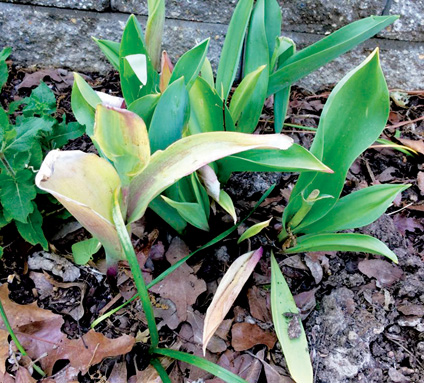Spent Spring Bulb Care

It’s raining again as I write this so I am going to postpone, yet again, covering a long list of May gardening chores. We would all just get frustrated since we can’t get most of them done right now so let’s focus instead on one of them that is very pertinent, what not to do with spent spring bulbs.
Spring bulbs range from tiny white snowdrops and traditional grape-colored muscari to the range of early to late-blooming tulips, daffodils and associated Holland-marketed bulbs.
My first experience with bulbs was a package of daffodils. I can still remember the excitement I felt checking them every morning for a bloom. When the day finally came, imagine my surprise to find the yellow flowers had green and purple markings. Unbeknownst to me, one of my younger brothers had decided to inject food dye into the bulbs, thereby forever altering my expectations of what I would find when I look at a blooming bulb. Nothing surprises me now but I digress.
After whatever is blooming, most people either mow or otherwise find creative ways to get rid of the remaining greenery. Here is a quick guide on what to do, and not to do, if you want bulbs that will continue to bloom year after year:
1. Tulips. After blooming, do cut off the dying flowers but leave the green leaves, even if they start yellowing. The leaves are solar collectors, storing energy in the bulb for blooms next year.
I also feed my bulbs a couple of tablespoons of bone meal mixed into the soil around the clump of bulbs after they bloom. You can add a handful of nicely-aged compost for the same effect, which is to give the bulbs a little extra food as they build up energy for next year.
2. Daffodils. If you want more daffodils, leave the flower heads on and let them go to seed to scatter and make more daffodils. If not, remove the seed head so the energy is focused on the bulb.
Do not mow, sit on, cover, braid, or otherwise mess with those green leaves. Like tulips, they are the solar collectors of the bulbs. If you want to have more flowers next year, the bulbs need to collect energy through the leaves.
So what to do about those unsightly, yellowing leaves?
Plant daffodils and tulips towards the back of your flower beds and landscaping areas. Add later-growing perennial plants in front so as the greenery turns yellow, the other plants grow up and hide the yellowing leaves.
This is also a good time to mark where you have your bulbs planted so you don’t inadvertently dig them up later. I use popsicle sticks broken in half to mark boundaries and, once the greenery has died back, add a layer of soil to plant something with shallow roots, like Cosmos and Zinnias.
If marking the spot is too much trouble, take pictures so you can refer to them later.
By letting your spring bulbs replenish themselves, you are bound to have spring flowers for many years to come.
Charlotte Ekker Wiggins is a beekeeper, gardener and sometimes cook. Published by El Dorado Springs Sun once in print and online with author’s permission. Copyright 2017, all rights reserved. This column may not be reprinted, republished or otherwise distributed without author’s permission. Contact Charlotte at gardeningcharlotte at gmail dot com.

SOLAR COLLECTORS – Once finished blooming, tulip leaves will start loosing color and dying off. Leave the leaves on the bulbs to collect energy for the bulb for next year’s blooming season. This year, tulips bloomed for a very long eight weeks so the bulbs will need extra energy to recharge the bulbs for next year.

THEY’RE BUSY – These daffodil bulb leaves are turning yellow as they die back from their spring flowering. I leave them alone until they completely die off so the bulbs can collect as much energy as possible for next year’s blooming season. (Photos by Charlotte Ekker Wiggins).



Facebook Comments